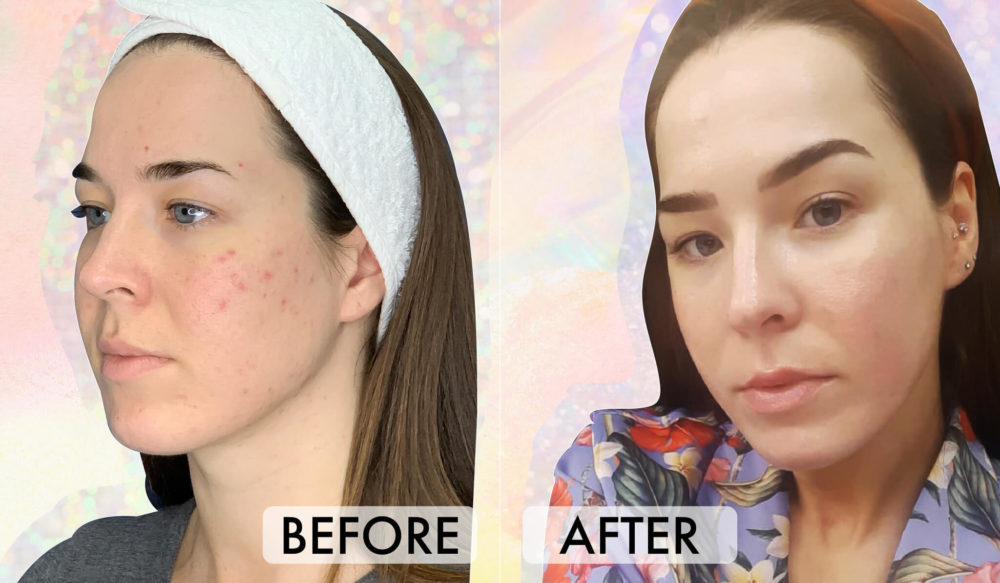Why You Need To Think Twice The Next Time You See A Whitehead
 via Giphy
via Giphy
Have you ever had a teeny tiny pimple, that no matter how hard you squeezed it, it never popped? Well, that’s probably because it’s wasn’t a pimple, it was milia. If you’re thinking milia-what? It’s because it’s not commonly known, and the problem is milia kinda looks just like a whitehead. To combat the confusion, we spoke to NY-based dermatologist and author of Beyond Beautiful; Dr. Doris Day. Here’s everything you need to know about those annoying little bumps…
What’s the difference between whiteheads and milia?
Disclaimer: They look the same, but they’re actually completely different!
Whiteheads: Dr. Day explains “Whiteheads (also called closed comedones) are a component of acne. They form when the contents of the pores get obstructed from reaching the surface of the skin. Contents of a whitehead may include skin cells, as well as the contents from the oil glands [sebum] that get blocked from exiting the pore. Once the surface of the skin’s exposed, either from the contents pushing through or from the thin layer overlying the pore, the cells get oxidized and turn black, creating a blackhead. So, a blackhead was first a whitehead.”
 Source: charnsitr/Shutterstock
Source: charnsitr/Shutterstock
Milia: “Milia do not occur within the pores, they’re trapped keratin (skin cells) that form a cyst. They can be deep and difficult to extract because there’s no pore or lining through which to push the contents” Dr. Day tells us. They typically occur around the eye area, eyelids, and on the upper cheek; where the skin is thinner.
 Source: vchal/Shutterstock
Source: vchal/Shutterstock
What causes milia?
“Milia can be a result of many different common skincare mistakes,” explains Dr. Day. Most notably they’re caused by skin care formulas that are too rich and therefore sit on the skin’s surface, resulting in dead skin build up. If you’re prone to milia, you should avoid products containing petroleum oil, paraffin or lanolin as these could trigger a milia breakout. Sun damage is another key cause, as well as hormonal changes and genetics.
How to treat milia
As tempting as it may be, try not to squeeze milia as you’ll increase the risk of scarring and you probably won’t manage to extract it. The main aim of your regime should be to boost skin cell turnover and rid yourself of any dead skin buildup: less dead skin cells = fewer milia. You should also try to avoid rich formulas that could cause milia to form. Here are the milia-busting skincare rituals you can incorporate into your daily regime:
The key is exfoliation…
Gentle exfoliation will help remove dead skin that’s blocking your pores and allow for easier penetration of other skincare products. This will reduce the chance of product pilling – when excess product sits on the skin’s surface and consequently clogs your pores. Chemical peels are also a great option as they contain chemical exfoliants; AHAs and BHAs, which will provide a more intense exfoliation. A chemical exfoliator is an enzyme or acid-based formula, which penetrates your skin, dislodging and dissolving the glue that binds dead skin cells together, while promoting skin regeneration.
We love The Ordinary AHA 30% BHA% Peeling Solution, $12, as it contains both BHAs and AHAs to remove the skin’s topmost layer, combatting blemishes, dullness, and most importantly, milia. The Dr. Dennis Gross Alpha Beta Extra Strength Daily Peel Packettes, $88, are amazing and super easy to use. Plus, there are three different formula strengths, so you can find an option that’s suitable for your skin type.
Posts You'll Love:
Other helpful daily habits…
Wear SPF daily: Increased sun exposure can trigger milia, which means it’s essential to wear SPF all year round. However, you need to be mindful of what SPF you choose, as you want to avoid heavy formulas. Instead, look for an SPF that’s non-comedogenic so it’s less likely to clog your pores. We’re obsessed with the Thank You Farmer Water Sun Project Water Sun Cream SPF50, $24, as it’s super lightweight and offers great protection.
 Source: The Ordinary, The Inkey List, Thank You Farmer
Source: The Ordinary, The Inkey List, Thank You Farmer
Incorporate retinol: “Retinols act on specific receptors, or targets in the skin, which helps to promote more normal maturation of skin cells. They also promote collagen production and lots of other healthy processes in different layers of the skin to help your skin look and feel healthy, smooth and even in tone,” Dr. Day explains. Our fave retinol is The Inkey List’s, Retinol Serum, $13, which combines 1% stable retinol and 0.5% granactive retinoid (retinol’s more potent sibling) with one of our all-time favorite oils, squalane, to hydrate and soothe the skin. Although you do need to be careful when you introduce retinol to your skincare regime, as it’s a potent active ingredient. Read our full guide to retinol here.
Steam: Facial steaming helps hydrate your skin and open your pores, allowing for better absorption of other skincare products. We like to steam before a DIY face mask; honey is a great DIY ingredient to incorporate if you have milia as it has anti-bacterial and anti-inflammatory properties. Find out how to steam like a pro here.
In-clinic treatments for milia…
Cryotherapy: Cryotherapy is an in-clinic procedure that uses ice-cold temperatures, more specifically liquid nitrogen, to freeze milia.
For any stubborn AF milia: If you’ve exhausted all options and have milia that just won’t budge, you can visit a dermatologist to have them removed. A dermatologist will pierce the milia with a sterile needle, and then extract the trapped keratin. We know this sounds simple, but don’t do this at home as you’ll increase the risk of scaring and could damage your skin.
Let us know what skin concern you’d like us to write about next.























Leave a comment